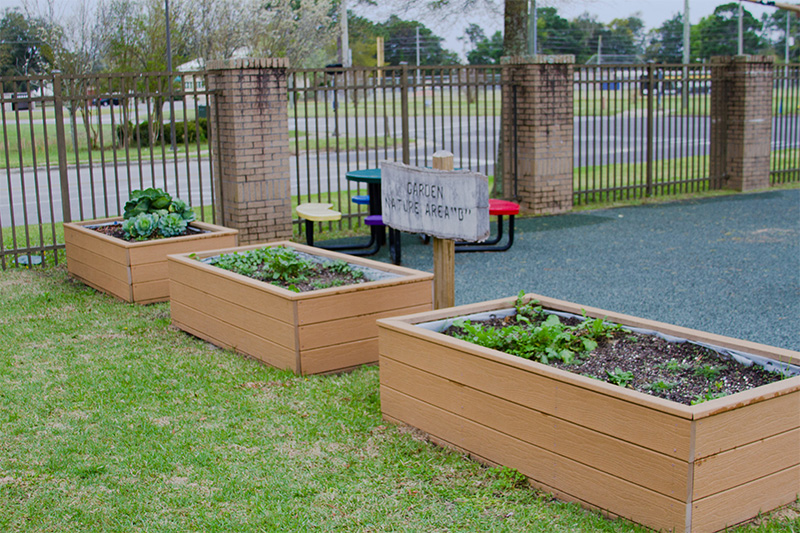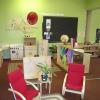- Teach staff members the importance of viewing the outdoors as an extension of the learning environment.
- Provide staff with the resources to effectively use the outdoors as an integral and rich learning environment across the curriculum.
- Model ways to organize outdoor spaces into interest areas that meet the needs of all children.
- Provide feedback on outdoor learning environments.
Learn
Teach
Have you noticed new outdoor or nature-based preschools or youth programs in your community? If so, you are not alone. There has been a tremendous increase in interest and enthusiasm for outdoor learning. This is, in large part, due to the many benefits that children, youth, and staff realize from time outdoors: children and youth can release energy, use loud voices, play vigorously, and engage in messy projects. Children can deepen their understanding of and respect for local plants and animals. Outdoor play also creates rich opportunities for science learning and social interactions, while promoting physical health and better sleep (Kinsner, 2019).
In child development centers, you can help staff reap many of these benefits by offering a blend of indoor and outdoor learning experiences. Much of what is done indoors can be easily adapted to the outdoor environment. There are four key considerations for working with staff as they make the outdoors an integral and rich learning environment for children ages birth through 12 years: Safety, Design, Space, and Accessibility. These four considerations are discussed in depth here.
Safety
Evaluate the outdoor environments regularly. Work with staff to make sure they do their own daily safety inspections before children use the space. Make sure the equipment is safe and the environment is free from preventable risks. You must consider fall zones, surfacing, access to shade, and the condition of materials and equipment. See lesson one of the Safe Environments course for more information. When you have concerns about the environment or children’s safety, address them immediately with the staff or management.
Work with staff to ensure safety while still offering children reasonable risk. Climbing equipment, trees, and logs can all present reasonable risk. Risky play allows a child to test their bodies and build independence and confidence. It always occurs with adult supervision and support, though. As with all kinds of development, adults can scaffold children’s emerging play skills. Adults observe carefully and offer ideas when the child has reached the edge of their abilities or encountered a problem (Grady, 2021).
Design
Outdoor spaces can offer many of the same interest areas and activities as are typically offered indoors in the child-development or school-age programs. For child-development programs, you might encourage staff to include sand, water, wheeled toys, games, construction, woodworking, quiet activities, science, and nature in their outdoor spaces (Colker, Dodge, & Heroman, 2016). For school-age programs, the addition of gardening, sports, fitness equipment, music, and natural habitats for exploration can help children learn beyond the school day.
Just as in the classroom or school-age program, staff must make sure outdoor spaces are organized for independence, easy use, and learning. During your observations, it is important for gross-motor play to happen safely in one area without disrupting activities in another area. For example, a basketball game should not play through children who are drawing with chalk. You also want to ensure quiet activities (art, chalk, blocks, sand, reading under a tree) are separate from loud and active activities (ball play, bikes, running).
Space
As a trainer or coach, you can help staff make the most of the space they have. Not all outdoor spaces are ideal, but that doesn’t mean you have to settle for a playground with only metal play structures and asphalt. You can help staff brainstorm and get creative. Your local home improvement store can be a great resource. Consider helping staff members fill plastic rain gutters with dirt and letting children use them as planters or sensory bins. Wading pools can become sand boxes or planters. Ask for volunteers to install bird feeders or raised garden beds. Recycled cardboard boxes, crates, PVC pipes, and milk cartons can all become amazing construction objects on the playground. Natural “found” materials such as shells and tree stumps can also add interest and excitement. Look into resources your organization can share with staff and families. The U.S. Fish and Wildlife Service’s handbook on creating schoolyard habitats is a great example.

Accessibility
There are two aspects to accessibility:
- Children have access to resources they need outdoors. Make sure children’s basic needs are met outdoors. Ensure access to restrooms, drinking water, and shade.
- The environment is accessible to all children. Consider the needs of individual children. Some children, especially those with disabilities or special needs, may have difficulties in the outdoor environment. Equipment may be inaccessible to children with motor impairments, the area may be frightening to children with visual impairments, or the amount of choice may be overwhelming to children with developmental delays. You can help staff make adaptations for these children just as you would in the classroom or program. This will be covered in more depth in Lesson Six.
Model
Just like with indoor environments, you should have an active role in making sure the outdoor environments provide a foundation for the curriculum. Help staff members make the most of the space you have. Spend time outdoors observing how children and adults use the space. Then get involved in helping make the space meet children’s needs. For example, you could:
- Organize a campaign to ask for donations of materials for a garden, dramatic play area, stage, or natural habitat.
- If your climate permits during some or all seasons, consider developing an outdoor classroom. Try flipping your approach to weather: only go indoors during inclement weather!
- Bring the curriculum outdoors. Creating a pollinator garden, a compost bin, a butterfly sanctuary, or a bug hotel can all be part of rich, project-based learning across science, math, social studies, and literacy.
- Ensure there are plenty of outdoor storage spaces for supplies and equipment. Model cleanliness habits by keeping the storage and play spaces tidy.
- Ask children questions about their outdoor play. Involve older children in identifying problems and coming up with solutions.
- Advocate to program leaders for outdoor play spaces and for time in the outdoors for all children and staff.
- Talk to staff and families about the importance of outdoor spaces.
- Look at the environment first when there is challenging behavior. Observe children and help staff members recognize when there is too much or too little structure, challenge, or direction for play.
Just as with indoor spaces, model curiosity and problem solving as you work with staff members. When a space needs arranging or rearranging, help staff members list all the activities, events, and materials that the space should accommodate. Remember that outdoor spaces are often shared across multiple classrooms, so all adults who share the space should be involved in this discussion. Use that list to set goals for the space and clearly define spaces that serve different functions. Importantly, keep open lines of communication across staff members who work different shifts in the same space. It is important that all staff members understand the purposes behind environmental arrangement and come to agreements about how the space will be maintained. Facilitate cooperation and negotiation about shared outdoor learning spaces by setting clear expectations, providing the materials necessary for any shared storage solutions, and seeking regular feedback on how the space is working for children and staff.
Observe
All staff members have different needs, perspectives, and experiences. Each will use the outdoor space differently. Match your coaching to each individual staff member.
It is your responsibility to ensure that staff members provide high-quality, engaging environments indoors and out. You should observe staff members and talk with them about the strengths and challenges of the outdoor space. For many programs, you will not have much flexibility in terms of changing the space itself; rather you will need to support staff members as they learn to use the space appropriately and maximize its potential.
Let’s begin by taking a look at an outdoor environment.
Case Example: Outdoor Learning Environment
Now reflect on what a trainer or coach could say and do after observing the learning environment:
See | You Saw:A well-maintained outdoor play space. There are a variety of areas for play and lots for the children to do. However, children were playing unsafely with balls and missing out on learning opportunities. |
|---|---|
Say | What You Might Say:
|
Do | What You Might Do:
|
Additional Examples of Outdoor Environments
As a trainer or coach, you will likely see a range of environments across a range of age groups. Watch the following videos to see examples of high-quality outdoor environments. Think about how you could work with staff to offer the kinds of experiences seen here.
A Range of Outdoor Learning Environments
Explore
Sometimes a playground isn’t perfect. It’s still very important that the outdoor space becomes an extension of the learning environment. In the Reflecting on Outdoor Learning Environments activity, you will reflect on the strengths and challenges of your program's space.
Apply
Use the following Outdoor Learning Environment Inventory to help you evaluate outdoor learning environments for child-development and school-age programs.
Glossary
Demonstrate
Children & Nature Network. (2019). Resources. https://www.childrenandnature.org/learn/tools-resources/
Dodge, D. T., Colker, L. J., & Heroman, C. (2016). The Creative curriculum for preschool (6th ed.). Washington, DC: Teaching Strategies, Inc.
Early Childhood Knowledge and Learning Center (2019). Nature-based learning and development. https://headstart.gov/learning-environments/article/nature-based-learning-development
Early Childhood Knowledge and Learning Center (2020). Outdoor experiences for infants and toddlers. https://headstart.gov/learning-environments/article/outdoor-experiences-infants-toddlers
Extension Alliance for Better Childcare (2019). Basics to keep children safe outdoors. https://childcare.extension.org/basic-tips-to-keep-children-in-child-care-safe-outdoors/
Grady, R. (2021). Message in a backpack: Encouraging your child through risks during play. Teaching Young Children, 15(1). https://www.naeyc.org/resources/pubs/tyc/fall2021/message-backpack-risks-during-play
KidsHealth (2019). Playground safety. https://kidshealth.org/en/parents/playground.html
Kinsner, K. (2019, May). Rocking and rolling. fresh air, fun, and exploration: Why outdoor play is essential for Healthy development. NAEYC. https://www.naeyc.org/resources/pubs/yc/may2019/outdoor-play-is-essential
National Association for the Education of Young Children. (n.d.) Books that inspire nature observations.https://www.naeyc.org/our-work/families/books-inspire-nature-observations
U.S. Fish and Wildlife Service. Education Programs.https://www.fws.gov/education-programs
U.S. National Park Service. (n.d.). Kids in parks.ttps://www.nps.gov/kids/index.cfm


